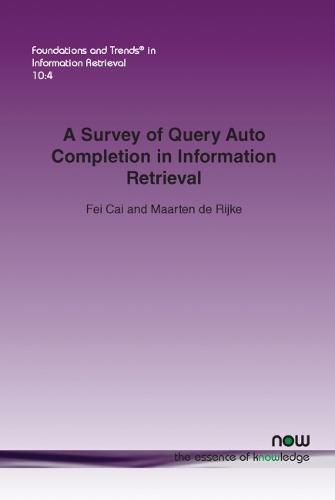Readings Newsletter
Become a Readings Member to make your shopping experience even easier.
Sign in or sign up for free!
You’re not far away from qualifying for FREE standard shipping within Australia
You’ve qualified for FREE standard shipping within Australia
The cart is loading…






This title is printed to order. This book may have been self-published. If so, we cannot guarantee the quality of the content. In the main most books will have gone through the editing process however some may not. We therefore suggest that you be aware of this before ordering this book. If in doubt check either the author or publisher’s details as we are unable to accept any returns unless they are faulty. Please contact us if you have any questions.
In information retrieval, query auto completion (QAC), also known as type-ahead and auto-complete suggestion, refers to the following functionality: given a prefix consisting of a number of characters entered into a search box, the user interface proposes alternative ways of extending the prefix to a full query. QAC helps users to formulate their query when they have an intent in mind but not a clear way of expressing this in a query. It helps to avoid possible spelling mistakes, especially on devices with small screens. It saves keystrokes and cuts down the search duration of users which implies a lower load on the search engine, and results in savings in machine resources and maintenance.
Because of the clear benefits of QAC, a considerable number of algorithmic approaches to QAC have been proposed in the past few years. Query logs have proven to be a key asset underlying most of the recent research. This monograph surveys this research. It focuses on summarizing the literature on QAC and provides a general understanding of the wealth of QAC approaches that are currently available.
This is an ideal reference on the topic. Its contributions can be summarized as follows: tt provides researchers who are working on query auto completion or related problems in the field of information retrieval with a good overview and analysis of state-of-the-art QAC approaches. In particular, for researchers new to the field, the survey can serve as an introduction to the state-of-the-art. It also offers a comprehensive perspective on QAC approaches by presenting a taxonomy of existing solutions. In addition, it presents solutions for QAC under different conditions such as available high-resolution query logs, in-depth user interactions with QAC using eye-tracking, and elaborate user engagements in a QAC process. It also discusses practical issues related to QAC. Lastly, it presents a detailed discussion of core challenges and promising open directions in QAC.
$9.00 standard shipping within Australia
FREE standard shipping within Australia for orders over $100.00
Express & International shipping calculated at checkout
This title is printed to order. This book may have been self-published. If so, we cannot guarantee the quality of the content. In the main most books will have gone through the editing process however some may not. We therefore suggest that you be aware of this before ordering this book. If in doubt check either the author or publisher’s details as we are unable to accept any returns unless they are faulty. Please contact us if you have any questions.
In information retrieval, query auto completion (QAC), also known as type-ahead and auto-complete suggestion, refers to the following functionality: given a prefix consisting of a number of characters entered into a search box, the user interface proposes alternative ways of extending the prefix to a full query. QAC helps users to formulate their query when they have an intent in mind but not a clear way of expressing this in a query. It helps to avoid possible spelling mistakes, especially on devices with small screens. It saves keystrokes and cuts down the search duration of users which implies a lower load on the search engine, and results in savings in machine resources and maintenance.
Because of the clear benefits of QAC, a considerable number of algorithmic approaches to QAC have been proposed in the past few years. Query logs have proven to be a key asset underlying most of the recent research. This monograph surveys this research. It focuses on summarizing the literature on QAC and provides a general understanding of the wealth of QAC approaches that are currently available.
This is an ideal reference on the topic. Its contributions can be summarized as follows: tt provides researchers who are working on query auto completion or related problems in the field of information retrieval with a good overview and analysis of state-of-the-art QAC approaches. In particular, for researchers new to the field, the survey can serve as an introduction to the state-of-the-art. It also offers a comprehensive perspective on QAC approaches by presenting a taxonomy of existing solutions. In addition, it presents solutions for QAC under different conditions such as available high-resolution query logs, in-depth user interactions with QAC using eye-tracking, and elaborate user engagements in a QAC process. It also discusses practical issues related to QAC. Lastly, it presents a detailed discussion of core challenges and promising open directions in QAC.